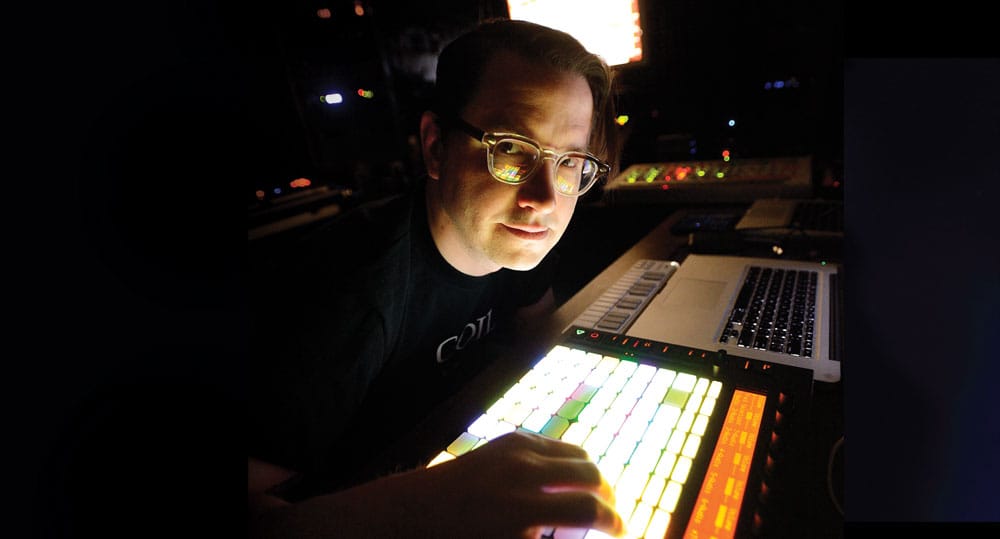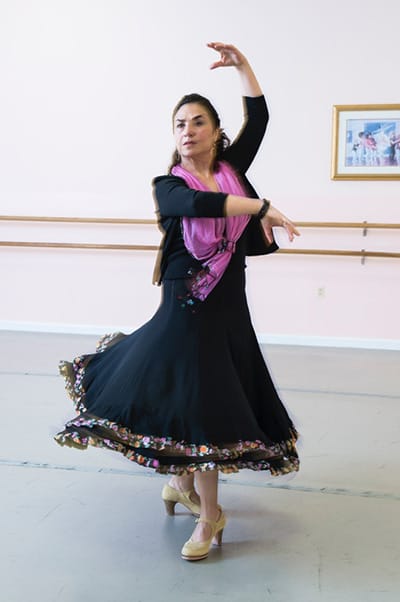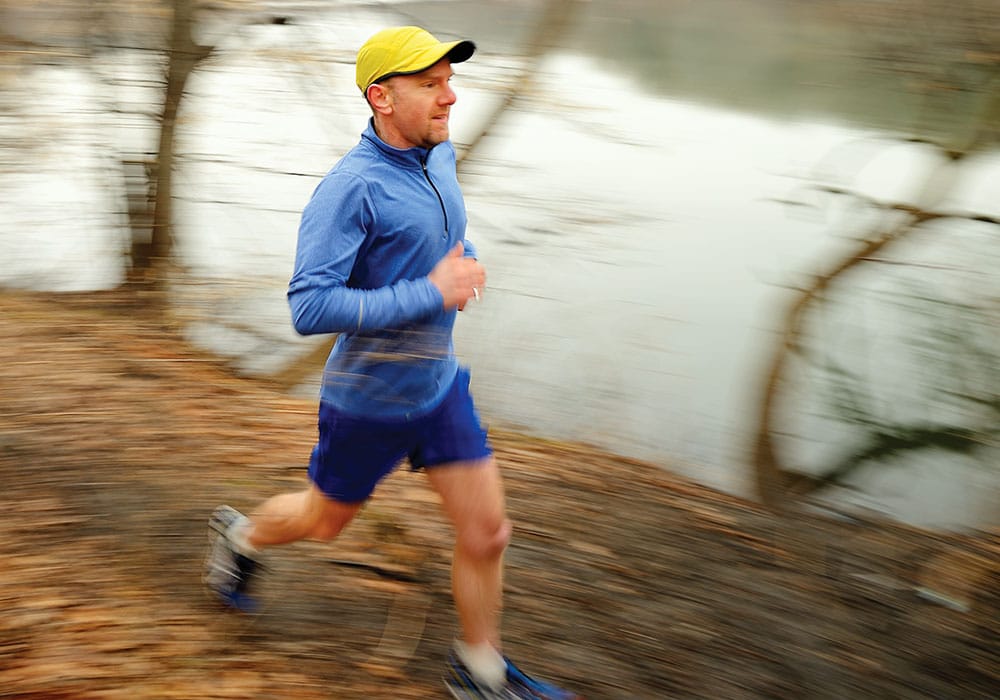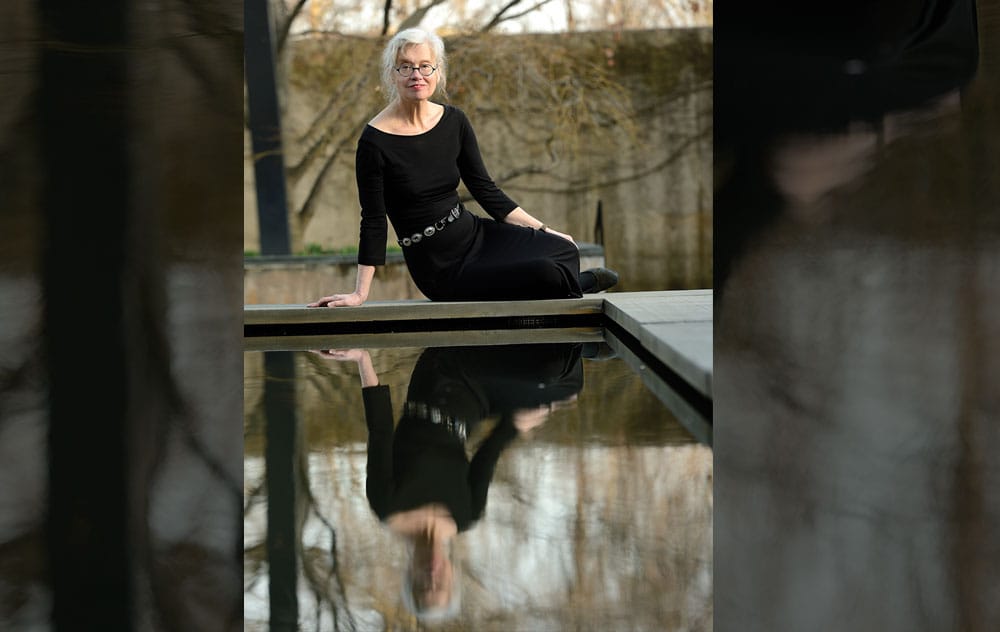A Sophisticated Sampler
The third floor of Drew Daniel’s Charles Village rowhouse looks every bit the proper professorial study—from the walls lined with bookshelves to the plush reading chair and desk. But down in the basement, racks of keyboards and jumbles of more obscure instruments lie waiting for Daniel to put down his pen and make music late into the night.
As one half of the instrumental electronic duo Matmos, Daniel has toured with well-known singer Bjork, performed at the Guggenheim, and DJ’ed at Yoko Ono’s art opening in San Francisco. And as an associate professor in Hopkins’ English department, he spends several months a year lecturing on Shakespeare.
“I like the ‘Jekyll and Hyde’ division,” Daniel says. “I have consciously tried to keep them separate … but I think at a deep level, they’re very connected.”
Daniel formed Matmos with his partner, M.C. “Martin” Schmidt, in the mid-’90s, and after being rejected by a few record labels, they began releasing music on their own. They recorded various sounds and digitally manipulated them to create a tapestry of surprisingly catchy music. Their samples often come from unexpected places: the noises made during surgery, or the sound of a goat spine rapping on a human skull. The idea of sampling is what connects Daniel’s music and literary sides.
“You’re not going to quote all of [Robert Burton’s] Anatomy of Melancholy—it’s 1,000 pages long,” he says. “You’re going to find the juicy, expressive part. That’s what I do when I listen to 40 minutes of Martin playing a human skull. … What’s the really juicy part, and how can I work with that and make it really articulate?”
Daniel is every bit as serious about being a professor as he is about his music career, though it has meant plenty of sacrifices.
“There were times when Karl Lagerfeld wanted me to go to Paris Fashion Week to play at a Colette party, and I had to grade papers about Macbeth written by 18-year-olds,” Daniel says. “But I don’t regret it, because I love being a professor. … With a classroom, with an audience, with a mosh pit, with a dance floor, you want to loop what you’ve selected and share it with people and energize them,” he says. “Catalyze something. Change them. That’s the goal.”
Proud to Dance
One night when Niloofar Haeri (left) was a grad student at the University of Pennsylvania, she saw director Carlos Saura’s adaptation of Carmen and was captivated by the raw passion and effortless grace of the film’s flamenco dancers.
“I could not sleep the whole night, I was in such a state of awe,” says Haeri, who is now chair of the Krieger School’s Department of Anthropology. “How could a dance be so beautiful and express so much?”
The film ignited a lifelong interest in flamenco, which would take Haeri to Spain and back, and deeply resonate with her decades later.
Not long after watching Carmen, Haeri came upon a group of flamenco dancers at an art fair in Philadelphia and sought out their teacher, a woman named Julia Lopez. Haeri and a classmate studied under Lopez for 10 years, learning the fluid arm movements and the “taka taka taka taka” foot rhythms. Flamenco can be at times melancholic or exuberant, but above all, it is a proud dance, Haeri says.
“You hold your head high, you make eye contact with the audience,” she says. “I’ve watched 70-year-old women give extremely emotional performances.”
While in graduate school, Haeri traveled to Lopez’s hometown of Pastrana, a mountainside village in Guadalajara, where she spent a month dancing flamenco. The villagers welcomed Haeri, whose olive-toned skin (she’s a native Iranian) almost let her pass as a Spaniard.
“It was a wonderful feeling, that we could dance in that context,” she says. “We put on a performance and the whole village came. It was jam-packed.”
After moving to Baltimore, Haeri briefly studied under Maria Morales, a renowned dance instructor, at the Peabody Institute. But Morales was getting older (she passed away in 2001 at the age of 89) and was accompanied by a pianist instead of the traditional flamenco guitarist. Haeri lost interest and quit after a few classes.
Years passed, and Haeri focused on her work at Hopkins, and published several books. She never mentioned her love of flamenco to her students, and rarely talks about it to others.
Earlier this year, Haeri learned of a new flamenco instructor named Alexa Miton and began taking classes at her Baltimore County studio in January. She was nervous about the effort it would take to relearn the dance, but she quickly fell right back into the familiar posture and expressions.
“It’s like my body remembered,” Haeri says. “My teacher told me, ‘Look at you! After all these years, you remembered.'”
An Ultra-Athlete
If Thomas Haine has a mantra, it is this: “Ordinary people can do extraordinary things.”
It’s a phrase he has come to understand and, ultimately, to embody. Haine, the Morton K. Blaustein Professor and Chair of the Krieger School’s Department of Earth and Planetary Sciences, runs 100-mile ultra-marathons along rocky mountainside trails—in 27 hours or less.
When he tells people about his hobby, “they don’t believe it, and then they think it’s crazy,” he says. But spend some time talking to him about it, and Haine makes the idea sound like a very long walk in the park.
As a young man, Haine never ran much. He started after college, and did a few 10Ks before attempting his first half marathon.
“I got excited by the fact that I could run farther and farther,” he says, “as long as I kept eating and drinking and paying attention to my blisters.”
By the time he joined Hopkins in 2000, Haine had finished a few marathons, when he learned about trail ultra-marathons. These races are longer than the traditional 26.2-milers and are run on dirt instead of pavement. The idea seemed absurd, but after his left knee needed surgery in 2004, he knew he needed to start running on softer dirt and gravel instead of asphalt.
Haine signed up for a 50K trail ultra-marathon at Gunpowder Falls State Park in 2006— and came in first place.
“It’s like a first-time visitor to the casino winning big,” he says. “Suddenly, I was hooked.”
Next came two more 50Ks (about 31 miles), then a 50-miler. By 2010, Haine worked his way up to the Mason-Dixon Longest Day, a 100K (about 63 miles) run through Maryland into Pennsylvania on the longest day of the year, in mid-June. Haine completed his first Massanutten Mountain Trails 100-miler (MMT100) in Virginia’s Shenandoah Valley in June 2011.
Haine shares his passion for running with his students, and has even recruited a few. One of his postdoctoral students, Inga Koszalka, paced him at MMT100 last year and also in 2012. And another student plans to pace him at the race this May.
“For some people, the ultra-spectacle is irresistible—they see how it happens, and then they want to try it themselves,” Haine says.
Running long distances is an endurance game, played out in the mind and body. If you can ignore the part of your brain that tells you to stop, Haines says, the rest is taking care of your body well enough to finish. He splits up the race into smaller chunks and never lets his mind linger on the bigger picture.
To stay hydrated, Haine drinks plenty of water, Gatorade, and a runner’s drink named Perpetuem. He snacks on PowerBars for the first six hours, then switches to solid food.
Every once in a while, Haine will allow himself to imagine—if only for a moment—what it will be like to finish the race.
“It feels like Christmas and my birthday on the same day,” he says.
Anchors, Aweigh!
On an ideal summer weekend Karen Fleming, a professor in the Department of Biophysics, and her husband, Patrick (a senior lecturer in the department), sail across the Chesapeake Bay and drop anchor in a creek on the Choptank River.
There, they cook steak and veggies and watch the sunset spill across the water, go for a swim, and retire into the cabin of their 34-foot Morgan sloop.
Fleming has loved sailing since she was a postdoctoral student at Yale, when she and Patrick would explore the waters of Long Island Sound. One of the main attractions of Johns Hopkins was its proximity to the Chesapeake Bay. And before she became a biophysics professor at Hopkins, Fleming lived on the boat for three weeks, cruising around the bay.
“I like the intensity of sailing,” she says. “It’s like science—you have to pay attention to it 100 percent when you’re doing it. It’s very engaging. And it’s fun.”
Surprisingly, sailing isn’t in Fleming’s DNA. She would know—she has traced her ancestry on her father’s side all the way back to the Revolutionary War. Her earliest known ancestor served in North Carolina and later moved to Kentucky.
“My genealogy is all land-locked,” she says. “So if it’s in my DNA, it hasn’t been expressed until now.”
Morning is an ideal time to set sail, before the motor boats stir up the waters, Fleming says. From their home at the headwaters of the Severn River, they can be in Annapolis in about two hours. Their boat is named El Dorado, a reference to the mythical city of gold.
“It came with that name, and it’s bad luck to change the name of a boat,” she says. “But it’s a nice name, I think.”
Fleming loves being outdoors. When not boating, she runs, bicycles, skis, and hikes. But sailing holds a special place in her heart.
“It’s fun, it’s adventuresome, it’s outdoors—it’s nature,” she says. “I could live on the water.”
The (Literary) Doctor Is In
For years, Jean McGarry, a professor and co-chair of the Writing Seminars, dealt with a debilitating kind of writer’s block. “I realized that I felt free, yes, to write, but when I saw what I had written, I had the impulse to destroy or bury it,” McGarry says.
McGarry overcame her writer’s block with the help of psychoanalysis, an interest that later blossomed into something of a second calling for the award-winning author.
Seven years ago, McGarry applied to become an academic associate at the Baltimore-Washington Institute for Psychoanalysis. First, she spent five years taking courses on child analysis, dreams, and case discussions, alongside aspiring psychoanalysts who were learning how to practice. Then she became a patient herself.
For McGarry, being psychoanalyzed was a bit disorienting. Patients are analyzed several times a week, often for years, and psychoanalysts don’t offer immediate suggestions or feedback. “I don’t like to talk on the phone because I like to see the face of the person I’m talking to,” she says. “So lying on the couch and having the other person be silent was hard for me.”
The final step in becoming a psychoanalyst is to see patients. But since McGarry never intended to practice, she analyzed the main character in a story by author Peter Taylor.
While McGarry hasn’t made Freud part of her classroom curriculum yet, she has explored aspects of psychoanalysis in the stories she writes. The topic comes up in her classes, and she even had an undergraduate student ask to pursue an independent study because she wanted to write about a mother with narcissistic personality disorder.
“The question I haven’t asked her yet is, Why are you so interested in this?” McGarry says. “I think I can guess.”
McGarry’s own psychoanalysis ended in 2012, and led to several breakthroughs in her writing process. She’s now on the board of directors at the institute, and even started a book club for psychoanalysts.
“I’ve turned them into my students,” she says. “Every once in a while, they will analyze the author and the characters, and find things students wouldn’t find.”
Heavy Lifting
For a moment, Floyd W. Hayes III stands at the foot of the bench press, mentally preparing himself before turning around and lying down on it.
“Come on, Floyd!” a man shouts from the crowd at the Maryland State Powerlifting Championships.
Hayes curls both hands around the bar, and the spotter helps him lift 303 pounds off the rack. The next 10 seconds seem like an eternity: Down comes the barbell, almost to Hayes’ chest, before he begins to push it back up.
Hayes’ legs shake with the effort as finally, his arms lock back in place, the weight suspended above him. It is 2010, and at the age of 67, the senior lecturer and coordinator of programs and undergraduate studies at the Center for Africana Studies has just set another state powerlifting record.
Today, Hayes is one of an elite group of power lifters over the age of 70. He competes in three events: deadlift, squat, and bench press, and has set national and state records for his age in all three.
As a young man, Hayes was an avid jogger and biker, but as he aged, those workouts fell by the wayside. One day in the mid-’90s, he met a power lifter named Doug Harney, who encouraged him to pursue the sport.
In 1999, Harney sent Hayes to a meet in Ohio where he set a national record for dead-lifting 525 pounds. Aside from the thrill of setting records and the feel of the weight in his hands, Hayes was drawn to the community of power lifters he met there.
“What I found were people who were extraordinarily supportive,” he says.
Three days a week at 5:15 a.m., Hayes makes the short drive to a nearby Gold’s Gym, where he spends around two hours lifting. His wife, Charlene Moore Hayes, Johns Hopkins’ vice president for human resources, supports Hayes’ powerlifting and attends his meets.
Most of Hayes’ students have no idea about his powerlifting, though he’s had a number of lacrosse players sign up for his classes. The first batch told him their adviser recommended Hayes’ class because he lifts heavy weights.
“I’m working on trying to stimulate them intellectually,” he says.







